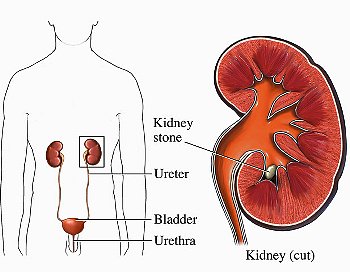Types of Kidney Stones
There are four main kinds of kidney stones

- Calcium-oxalate
- Struvite
- Uric acid
- Cystine
Kidney Problems
Kidney disease often has no symptoms until it is very far along. The only way to be sure how your kidneys are working is to get tested. If you do have symptoms, they might include:

- Feeling sick to your stomach often
- Feeling tired or dizzy often
- Swelling in your feet, hands or face
- Back pain
- Bloody, foamy or dark-colored urine
- High blood pressure
- A change in how often you go to the bathroom (pee more or less often)
If you think you may have a kidney problem, talk to your doctor. Kidney problems that are caught early can be treated. Kidney problems that are left untreated may lead to permanent damage.
Preventing kidney stones
- The best way of preventing kidney stones is to make sure you drink plenty of water each day to avoid becoming dehydrated.It is very important to keep your urine diluted to avoid waste products forming into kidney stones.
- Change your diet. This may be helpful, but it depends on what is causing your kidney stones. Your doctor may do more tests before deciding whether changing your diet will help reduce your risk for getting another stone.
- Medicine – If you get more kidney stones despite drinking more fluids and making changes to your diet, your doctor may give you medicine to help dissolve your stones or to prevent new ones from forming. For more information, see Medications.
Kidney Stones Treatment
The common situations
- Most stones that cause renal colic are small and pass out with the urine in a day or so. You should drink plenty of fluids to encourage a good flow of urine. Strong painkillers are often needed to ease the pain until you pass the stone. No other treatment is usually needed.
- Some stones that form and stick in the kidney do not cause symptoms or any harm. They can just be left if they are small.
- Sometimes you may be offered medicines to help the stone pass through, such as nifedipine or tamsulosin.
In some cases
Some stones become stuck in a ureter or kidney and cause persistent symptoms or problems. In these cases, the pain usually becomes severe and you may need to be admitted to hospital. There are various treatment options which include the following:
- Extracorporeal shock wave lithotripsy (ESWL). This uses high-energy shock waves which are focused on to the stones from a machine outside the body to break up stones. You then pass out the tiny broken fragments when you pass urine.
- Percutaneous nephrolithotomy (PCNL) is used for stones not suitable for ESWL. A nephroscope (a thin telescope-like instrument) is passed through the skin and into the kidney. The stone is broken up and the fragments of stone are removed via the nephroscope. This procedure is usually done under general anaesthetic.
- Ureteroscopy is another treatment that may be used. In this procedure, a thin telescope is passed up into the ureter via the urethra and bladder. Once the stone is seen, a laser (or other form of energy) is used to break up the stone. This technique is suitable for most types of stone.
சிகிச்சை முறை Treatment
Full body Alignment (முழு உடல் கட்டமைப்பு சிகிச்சைகள்)
மொத்த சிகிச்சைகளின் எண்ணிக்கை – 21
- முதல் 7 சிகிச்சை வாரத்திற்கு 2 முறை (1st 7 treatments weekly 2 times)
- இரண்டாவது 7 சிகிச்சை வாரத்திற்கு 1 முறை (2nd 7 treatments weekly 1 time)
- மூன்றாவது 7 சிகிச்சை மாதத்திற்கு 1 முறை ( 3rd 7 treatments monthly 1 time)
Kidney Stones Treatments
சிகிச்சை முறைகள்
இங்கு சிறுநீராகக்கற்களை கறைக்க foot Reflexology (பாதபிரதிபளிப்பியல் சிகிச்சை)பிரதான சிகிச்சையாக அளிக்கப்படும். இதனுடன் அக்குபங்சர் சிகிச்சையும் சில மூலிகை மருந்துகளும் பரிந்துரைக்கப்படுவதால் 1 வாரத்திலிருந்து 1 மாதத்திற்குள் சிறுநீர் வழியாகவே கற்கள் முழுவதும் கரைந்து வெளியேறிவிடும். பிறகு scan பரிசோதனை மூலம் கற்கள் கரைந்திருப்பதை செய்து கொள்ளலாம்.
Note :
நோயாளிகள் வரும்போது சிறுநீரக கற்கள் இருக்கிறது என்பதற்கான scan பரிசோதனை முடிவுகள் இருந்தால் எடுத்து வரவும்.
